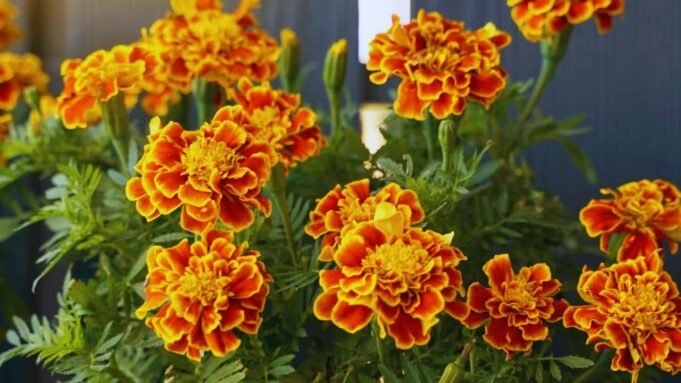Every year on November 1st and 2nd, Mexico bursts into a vivid celebration known as Día de los Muertos, the Day of the Dead. This beautiful tradition honors loved ones who have passed away, blending ancient Aztec beliefs with Catholic customs.
Among the candles, sugar skulls, and offerings, flowers play one of the most symbolic roles, transforming altars and graves into vibrant displays of love and remembrance.
Why Flowers Matter?
Flowers are more than offerings; they are a language of remembrance. Each bloom embodies the fleeting nature of life and the eternal cycle of renewal. Their vibrant colors symbolize vitality and hope, while their fragrance is believed to guide spirits back to the living. According to tradition, the brightness of each petal helps souls find their way from the spirit world to their family’s ofrenda, the altar built in their honor.
For many, arranging flowers is a ritual of love. Families travel to local markets days before the celebration, choosing blossoms with care, sharing stories of those they’ve lost, and laughing together as they prepare the decorations. The act itself becomes a celebration of life, one that unites generations in memory and joy.
The Symbolism of Flowers in Día de los Muertos
Flowers are not merely decorations; they are spiritual messengers. Their fleeting beauty reflects the cycle of life and death, while their fragrance is said to guide the souls of the departed back to the world of the living. Each bloom carries a message of love, purity, or memory, making them an essential part of this heartfelt holiday.
Read More: Lake Xochimilco
The Most Iconic Flower: Marigolds (Cempasúchil)
The marigold, or cempasúchil in Nahuatl, is the undisputed flower of Día de los Muertos. Known as the “flower of the dead,” its golden-orange petals are believed to light the way for returning spirits. Ancient Aztecs associated marigolds with the sun and the divine cycle of life.
During the celebration, streets, altars (ofrendas), and cemeteries glow with marigold garlands and petal paths, symbolically guiding loved ones home through their bright color and scent.
Cempasúchil: The Flower of the Sun
The cempasúchil, or Mexican marigold, is the beating heart of Día de los Muertos. Its name comes from the Nahuatl word cempoalxóchitl, meaning “twenty flowers,” a reference to its many petals. Ancient Aztecs believed it was a sacred flower given by the gods, connected to the power of the sun and the afterlife.
During the celebration, marigold petals are scattered in trails leading from doorways to altars, forming a golden path believed to guide spirits home. Their intense color and earthy scent represent both the warmth of life and the brilliance of memory. Fields of cempasúchil bloom across Mexico every October, painting the landscape in gold and orange, a living reminder that death, too, has beauty.
Read More: Best Things to Do in Santa Fe, New Mexico
Beyond Marigolds: The Meaning of Other Flowers
While marigolds are the centerpiece, many other flowers contribute to the beauty and symbolism of Día de los Muertos.
- Cockscomb (Terciopelo Rojo): Deep red and soft to the touch, this flower represents affection and the blood that connects all generations.
- Chrysanthemums: In Mexican culture, these blooms symbolize death but also respect and peace, often used on graves to honor ancestors.
- Gladiolus: Tall and graceful, they express integrity and moral strength, traits admired in those who have passed.
- Baby’s Breath (Nube): These delicate white flowers symbolize purity and are often placed to children’s altars, reminding families of innocence and eternal love.
- White Calla Lilies: With their elegant shape and calm presence, they symbolize spiritual rebirth and the continuation of the soul.
Each of these flowers brings a unique voice to the altar; together, they create a dialogue between the living and the dead, between remembrance and renewal.
Other Popular Flowers Used During Día de los Muertos
- Chrysanthemums (Crisantemos) – A common funeral flower in Mexico, chrysanthemums symbolize death, peace, and respect. Their full, rounded blooms honor ancestors with grace and dignity.
- Baby’s Breath (Nube) – Often used as a delicate filler, these small white flowers represent purity and innocence, especially for the souls of children celebrated on November 1st (Día de los Angelitos).
- Cockscomb (Terciopelo Rojo) – With its deep red, velvety texture, this flower symbolizes everlasting love and the blood of life. It adds richness and depth to floral arrangements.
- Gladiolus – Tall and elegant, gladiolus flowers signify remembrance, strength, and moral integrity, qualities attributed to beloved ancestors.
- White Calla Lilies – These striking blooms represent peace, rebirth, and spiritual transformation, offering a serene contrast to the colorful marigolds.
How to Arrange Flowers for Altars and Graves?
Traditional ofrendas are decorated with marigold garlands, vases of chrysanthemums, and petals arranged into crosses or pathways leading to photographs of the departed. Many families create intricate floral arches or designs that blend traditional symbolism with artistic flair.
At cemeteries, graves are lovingly covered with fresh petals, candles, and personal items, creating a beautiful space for prayer and remembrance.
Read Also: Top All-Inclusive Resorts in Mexico
Where to Find Día de los Muertos Flowers?
In Mexico, local markets like Jamaica Market in Mexico City come alive in late October with mountains of marigolds, chrysanthemums, and cockscombs. Farmers sell their freshest blooms to families preparing for the celebration.
If you’re outside Mexico, florists and Latin American shops often stock marigolds and other symbolic flowers around this time. Always choose vibrant, fragrant flowers; they are believed to be more effective in guiding spirits home.
Modern Interpretations and Global Influence
Día de los Muertos has transcended borders, and its floral traditions have inspired communities around the world. From Los Angeles to Tokyo, marigold installations and themed festivals celebrate this Mexican heritage. Artists and designers use marigolds in fashion, home décor, and public art, keeping the spirit of remembrance alive while introducing new generations to this meaningful tradition.
Creating the Ofrenda: A Floral Expression of Memory
Building an ofrenda is an act of storytelling. Families design these altars to reflect the personality of the departed, decorated with photographs, food, candles, and, of course, flowers. Marigolds often frame the altar, while white flowers bring a sense of peace and balance. Petals are arranged into paths or circles, representing the eternal cycle of life and death.
Some households craft elaborate floral arches to symbolize the gateway through which spirits enter. In cemeteries, families spend the night cleaning, decorating, and celebrating beside the graves of their loved ones. The flowers become offerings of gratitude—tokens that say, “You are still remembered. You are still loved.”
Also Read: Best Mexican Fruit
From Tradition to Art: The Modern Bloom of a Timeless Symbol
Today, the floral beauty of Día de los Muertos reaches far beyond Mexico’s borders. Artists and designers reinterpret marigolds in murals, fashion, and installations worldwide. Cities like Los Angeles, Madrid, and Tokyo now host Día de los Muertos events featuring massive marigold displays and floral sculptures.
Even so, at its heart, the tradition remains deeply personal. Whether in a grand parade or a humble home altar, the flowers continue to express what words cannot, the enduring presence of love after loss.
A Deeper Reflection: What Flowers Teach Us About Life and Death
The use of flowers during Día de los Muertos reminds us of a universal truth: that death is not an end but a transformation. Just as flowers bloom, fade, and return each season, so too do souls live on in memory and love. The vibrant marigolds and soft lilies serve as metaphors for our own lives, brief, beautiful, and eternally connected to something greater than ourselves.
Through their color and fragrance, these flowers help us celebrate not what we’ve lost, but what continues to live within us.
Conclusion
Flowers for Día de los Muertos are far more than colorful ornaments; they are bridges between worlds. From the golden marigold to the peaceful white lily, each bloom carries a story of love, memory, and the eternal bond between the living and the dead. Through their beauty and fragrance, they remind us that even in death, life continues to bloom.




![Are There Sharks in the Sea of Galilee?-[Names, Facts, and History] Are There Sharks in the Sea of Galilee](https://tourinplanet.com/storage/2025/11/Are-There-Sharks-in-the-Sea-of-Galilee-238x178.jpg)




![Are There Sharks in the Sea of Galilee?-[Names, Facts, and History] Are There Sharks in the Sea of Galilee](https://tourinplanet.com/storage/2025/11/Are-There-Sharks-in-the-Sea-of-Galilee-100x75.jpg)





